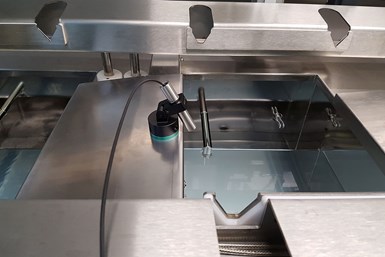In-line Monitoring for Automated Immersion Cleaning Systems
Ecoclean’s Acoustic Performance Measurement (APM) system provides in-line measurement of ultrasonic frequency and power in fully automated immersion cleaning systems on a batch-by-batch basis or at defined time intervals, such as once a shift, day or week.
The APM monitors ultrasonics parameters in-line for each batch using special microphones placed in a fixed position at the edge of the tank, which record the frequency and power. Analysis, evaluation and storage of the collected data are carried out by the measuring system’s software. Photo Credit: Ecoclean
Ecoclean’s APM (Acoustic Performance Measurement) solution offers reproducible, in-line batch monitoring with automatic analysis for ultrasonic frequency and power in fully automated immersion cleaning systems. The system is capable of monitoring the parameters of ultrasonic frequency and power in-line at each processing station and for each batch.
The system includes special directional microphones which are placed in a fixed position at the edge of each tank, and directed toward the center of the bath surface. Thus, measurements are carried out without any movement or contact, ensuring reproducible results and enabling them to be precisely assigned to each particular batch, the company says. Analysis, evaluation and storage of the data are carried out by the software of the measurement system.
Under identical conditions, the microphone records the sounds emitted by the cleaning medium under identical conditions for each batch. The measured ultrasonic frequency and power values are continuously transmitted to the system’s software, where they are evaluated by algorithms and compared with previously defined and stored set point values of the part-specific cleaning program. Should there be any deviations, the system issues a warning or error message. To rule out the possibility of sounds from surrounding tanks falsifying the measurement results, the software detects and masks out any interfering signals.
All data and evaluations recorded during in-line monitoring by the APM are automatically transferred to the cleaning machine’s batch logging system, which comes as standard. It is said this makes it easy to ensure and prove that the ultrasonically induced cavitation determined during validation of the cleaning process has been adhered to in production for each batch.
If ultrasonic parameters do not need to be recorded for each batch, the APM can also be used to monitor parameters at defined time intervals, such as once a shift, day or week. For this measurement strategy, a microphone is fixed-mounted to the automatic transport system (ATS), so that here, too, measurements are made without contact with the medium and their reproducibility is guaranteed. For this check, the ATS advances to the respective tank where it measures both the frequency and the sound power. When the software analyzes and evaluates the data, the values measured are compared with set parameters defined during validation of the cleaning process for the treatment station.
The measurement results are archived automatically in the machine’s programmable logic controller (PLC), meaning that proof can also be supplied over a longer period of time. Compared to previous practice, even this application option of the new APM system offers far more reliable results and thus significantly higher process reliability, the company says.
Related Content
-
Environmentally Friendly Model 550 Versatile Parts Washer
PMTS 2023: This washer is useful in a variety of applications, including tool rooms, maintenance operations, low production and precision cleaning.
-
Kyzen Solvents Provide Safe Parts Cleaning
The SLV901 and SLV803 solvents are formulated to maintain cleaning efficacy while providing a safe, environmentally friendly alternative to processes that use PFAS and HFCs.
-
Parts Cleaning Sector Shifts Energy Toward Regulatory Changes
With changes in EPA regulations regarding the use of some popular cleaning fluids, cleaning suppliers and end users are readjusting business strategies and/or cleaning processes to meet new requirements.

















